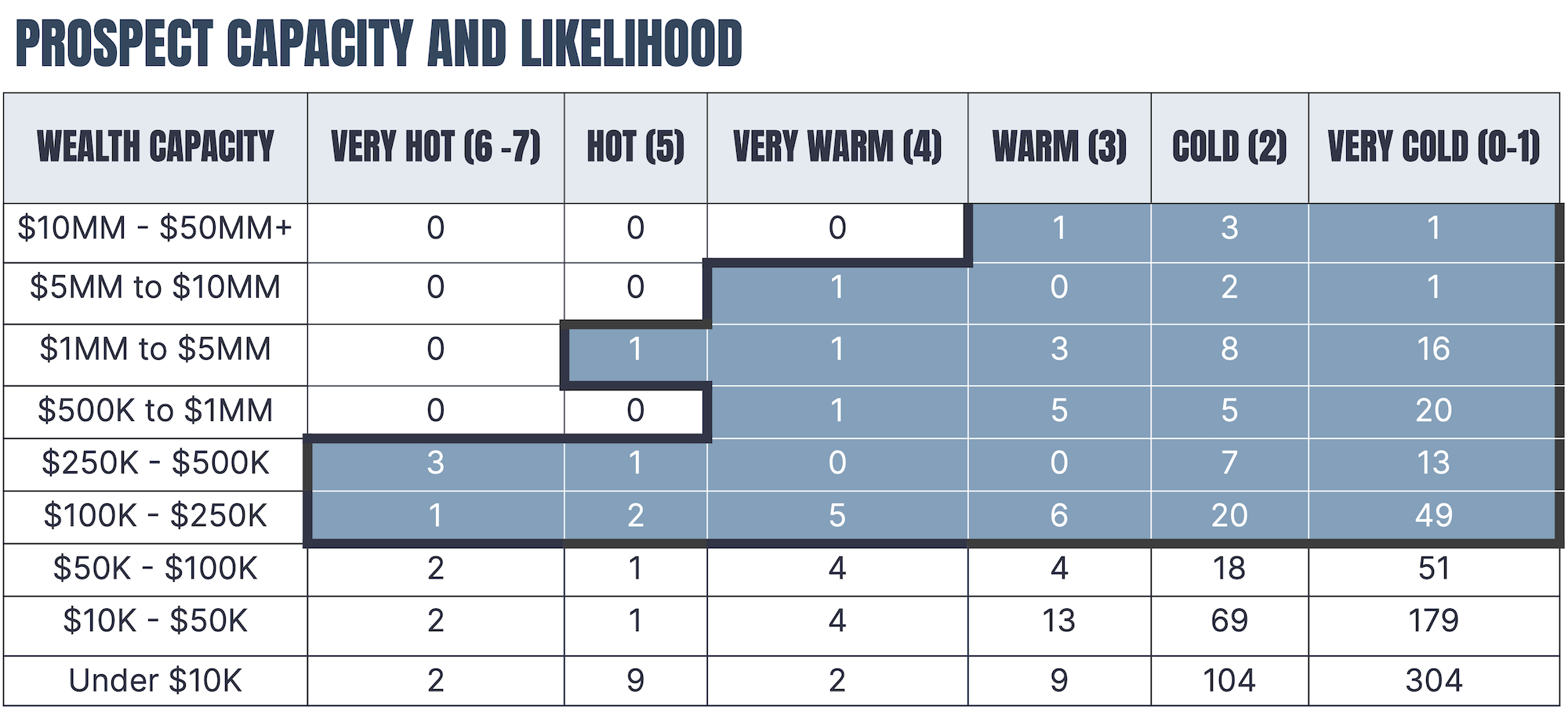Using Donor Analytics to Develop Your Donor Engagement Strategy

By Stephanie Willis, Senior Manager, Prospect Development
Gone are the days when nonprofit professionals and board volunteers convened around a table to hypothesize about a prospect’s inclination to give and ranked prospects based on recent giving history. While relationship insights and staff intuition remain important, there is both an art and a science to fundraising. Intuition (the art) combined with donor analytics (the science) will generate the best fundraising results.
Where to start with donor analytics
If you are like many nonprofit professionals, you know your organization needs help with your donor database, but you may not be quite sure where to start. When I begin working with a new client, I help them define the problem they are trying to solve. Once we understand your challenges, then we can help optimize your data analytics and strategy to increase your return on investment. We often utilize data to prioritize which existing donors to ask for which appeal because it is more cost effective to cultivate people who are already giving to your organization versus acquiring new donors.
CFA donor analytics can help answer:
- How can my organization maximize philanthropic investments?
- How can we optimize our organization’s database infrastructure to support our fundraising goals?
- Is anyone on my team consistently tracking and recording donor engagement data such as event attendance and volunteer participation?
- How inclined are prospects to support our organization, and how does their inclination align with their wealth capacity?
- Are there untapped pockets of opportunity in our database?
- Is our organization staffed to properly manage the scale of giving opportunities?
Analyzing data to determine a donor’s inclination to give
Inclination analysis is a way to predict which prospects have the potential to move from having capacity to give to being likely to give with the right outreach, cultivation, and engagement. We use donor inclination scores to illustrate how willing and interested the people in your database are to give to your organization based on their past behavior. We develop the scores based on a customized, data-driven points model and project the potential size of gifts by combining this information with a wealth screening of your database.
Here are examples of prospect prioritization used to prepare for a sample capital campaign.

The shaded boxes represent 176 prospects from a sample core prospect list with the greatest campaign potential. The blue section represents prospects for six-figure gifts. In this example, the “cold” and “very cold” prospects will need additional cultivation to determine if they are viable prospects for a major campaign, while the “warm” to “very hot” are more likely to be ready to make a commitment soon.

The range for these projections comes from the low and high range of the wealth capacity score, using a 5-year pledge commitment.
Most organizations discover through an inclination analysis that, on average, 75% to 90% of their donor database falls in the “cold” category. These may be lapsed or infrequent donors, but they are in your database for a reason. Many nonprofits solicit the same people again and again or buy data in pursuit of new donors instead of cultivating the “cold” prospects. Greater opportunity to move prospects from “cold” to “warm” exists when you increase engagement through strategic cultivation and donor communications.
Check out our Donor Communications Guide to learn how changing or increasing your donor communications tactics can increase your return on investment.
Most development professionals rely on a “moves management” system to track cultivation of prospects along a continuum of giving. One person might be a past donor at risk of disengagement while another has steadily increased their giving over time. At CFA, we call this system the Donor Cultivation Cycle, and data analytics plays a key role in determining where your prospects lie within the cycle. Today’s technology tools bring increased accuracy to data analytics and can help you track when you have engaged with a prospect.
- Consultant Tip: Have one person on staff assigned as data manager or prospect manager. This role is especially crucial during any campaign outside of your regular annual giving effort. Ensure that this person is trained in the concept of moves management and how to maximize database tools.
Good tracking is key
How you collect, maintain, and track donor engagement informs how you determine and refine a donor’s inclination score. Tracking donor engagement is also a way to uncover trends that inform the next best steps to reach your goals. Tracking does not have to be cumbersome, and it must be done year-round.
Many software applications will allow you to tag database records to enable you to match individuals with gifts and appeals. This is a great way to build new insights about your donors. For example, if you know that Donor A gave $100 through a text-to-give initiative but has never responded to direct mail solicitations, or that Donor B pledged $1,000 to a major gifts campaign at an event, and Donor C made a $25 contribution online from a postcard mailer QR code, then you can use this information to customize your outreach strategy and increase response rates.
- Consultant Tip: If you are not sure which message will best resonate with a segment of your donors or prospects, start with an “A/B test”: send out two versions of a message — one that is heartwarming and one that is transactional — and track which gets a better response from which people. This can help you tailor future messaging.
When donor analytics is right for you
Taking a deeper dive into data analytics and donor inclination can be done anytime your organization is raising annual dollars and cultivating donors for special projects and future campaigns. For a capital campaign, I recommend analyzing your database and prioritizing prospects at least three to six months before you expect to launch a campaign.
CFA donor analytics helps shape fundraising strategy by harnessing the nuances of donor inclination, database training, and wealth screening, which can optimize moves management, cultivation steps, and best practices to increase donor engagement.
Reach out today to see how CFA can help you harness data analytics in your fundraising strategy.
Stephanie Willis, Senior Manager, Prospect Development
Stephanie has over 10 years of experience in prospect research, prospect management, and data analytics at both higher education and nonprofit organizations. At CFA, Stephanie’s responsibilities include establishing strategy, procedures, and processes for prospect research, prospect management, and data analytics. Stephanie is Blackbaud-certified in Raiser’s Edge NXT and Raiser’s Edge and has a master’s degree in library science. Additionally, Stephanie is a Gallup-certified Strengths coach and has a passion for helping others understand, apply, and integrate CliftonStrengths results into their lives and work.

